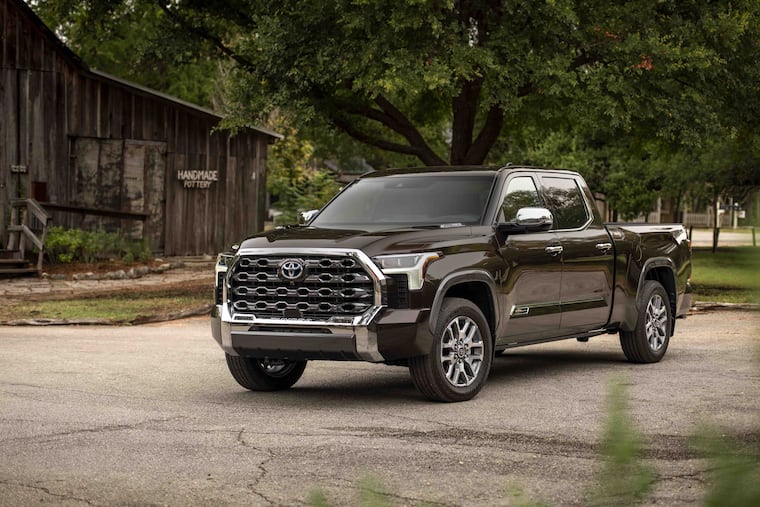2022 Toyota Tundra: Is a giant leap forward enough?
After testing the 2022 Ram 1500 Laramie G/T Crew Cab 4x4 last week, the 2022 Toyota Tundra 4x4 Limited Crewmax 5.5 gets a workout. The Tundra is much better than it was, but it hadn't been that great.

2022 Ram 1500 Laramie G/T Crew Cab 4x4 vs. 2022 Toyota Tundra 4x4 Limited Crewmax 5.5: Full-size haul-off.
This week: 2022 Toyota Tundra
Price: $60,188 as tested. The TRD Off-Road Package added some cool interior touches, 20-inch wheels, and off-road functions for $3,085; rock rails, $625; red paint, $425; bed mat, $195; more noted below.
Conventional wisdom: Motor Trend liked the “modern technology, standard V-6 twin-turbo engine, spacious, comfortable cabin,” but not the “middling material quality, bouncy ride with Bilstein shocks.”
Marketer’s pitch: “Born for adventures off the grid.”
Reality: Toyota keeps making the big Tundra more drivable.
What’s new: The all-new 2022 Tundra gets new sheet metal, engine choices, and a 12,000-pound towing capacity for the new generation.
Up to speed: The 3.5-liter twin turbo V-6 provides 389 horsepower and 479 pound-feet of torque. The Tundra reaches 60 mph in 6.2 seconds, according to MT, a match for the hot-rod Ram tested last week.
A hybrid version boosts horsepower to 437 and torque to 583 pound-feet, and EPA estimates don’t point to any fuel savings, so that’s probably not a reason to consider that engine.
Shifty: The 10-speed automatic transmission offers no shifting joy, unlike the Ram 1500 G/T; plus and minus movements allow only for gear limiting, for downshifting and such. The shifter operates simply, and the transmission does its work without a lot of whine or abrupt shifts.
» READ MORE: 2022 Ram 1500 Laramie G/T: Hot-rod pickup with a less subtle touch
On the road: Despite its massive size, the new Tundra handles like a much smaller pickup, revealing just how far Toyota’s suspension team has come. I christened a 2012 version “floppy”; then I drove a 2018, which handled much better, but still was dubbed “the bounciest truck” by Sturgis Kid 4.0.
This time around, I kept the Tundra mainly in Eco mode to save a few pennies on gasoline, and handling reminded calm in spite of the MT-maligned Bilstein shocks.
Furthermore, the Tundra got put to the test — up north to Sturgis Grandma 1.0′s, east to Philadelphia, out to Lanchester landfill, and south to Delaware. My only concession to the vehicle’s size came on Route 422 through Reading, where the curves were a little more than could be handled at my usual highway speeds.
Country roads are also a delightful place to be, and narrow paths don’t give any cause for concern. Bumpy paths could be felt fairly distinctly, but only on the worst of them.
Off the road: I took the Tundra across the hilly, damp Sturgis yard in 4Low for some cleanup work, and there was never a slip of the tires. Switching the drive mode can be more challenging than in other trucks: The switch is simple, but engaging generally took a few tries.
Driver’s Seat: The Tundra featured heated and cooled SofTex seats, which were roomy and comfortable through long hauls. I never felt any fatigue.
Friends and stuff: The rear seat provides plenty of space for head, legs, and feet. The seat has a decent angle, often not so in a crew cab pickup.
The bed step ($399) didn’t really provide any great ease of accommodations that I could find. The Ram offers much more flexibility with its swing gate.
» READ MORE: 2018 Toyota Tundra: A fresh look with a ride ’em cowboy ride
The bed is a standard 5.5-feet long, so with the tailgate down it’s about 8 feet. With this in mind, automakers should start providing buyers with rear cameras that are operable when the gate is down. The rear automatic braking should also be turned off, because it’s really annoying to fight backing up a truck that keeps sensing a fake disaster impending. A 6.5-foot and 8.1-foot bed are the other choices.
And despite the trumpeted 12,000 pounds of towing, the Ram is still higher at 12,750. Payload is also below at 1,940 pounds max versus 2,300 in the Ram.
Play some tunes: The JBL 12-speaker premium audio ($585) is operated through a truly massive 14-inch touchscreen, with just a lone volume dial standing out from the pixels.
Sound from the system is about an A-, which also shows how far Toyota has come.
Night shift: The premium LED headlights are part of the $395 Limited Premium Package, which also adds towing technology, and they provided fairly good coverage of the road. I found them to be a little short at first but managed to adjust to them quickly. Interior lights are a little too subtle, especially in such a huge cabin.
Fuel consumption: I was warned that I might be experiencing very low teens by a Tundra expert, but the test vehicle hovered just below 16 mpg through the week of testing. Still, the prospect of a $120 fill-up is daunting, and someone really needs to devise a way to move all this cargo using less fuel.
Where it’s built: San Antonio, Texas
How it’s built: Consumer Reports predicts the Tundra reliability to be a 3 out of 5, a match for the Ram 1500.
In the end: The Tundra is getting much better each time I test it, but that’s only putting it on par with where the others already were.
The Dutch doors in the Ram 1500 make it a perfect companion for people who haul a lot of messy stuff, and the larger capacities make it a winner, as well.